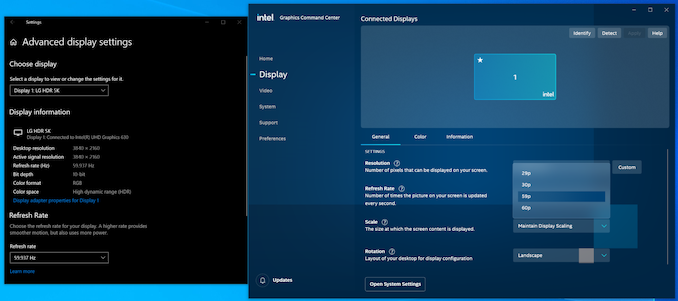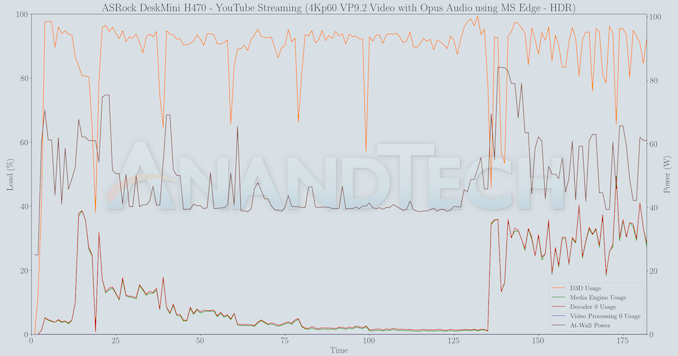ASRock DeskMini H470 Review: A No-Frills LGA 1200 mini-PC Platform
by Ganesh T S on December 29, 2020 8:00 AM ESTHTPC Credentials - Display Outputs and Streaming Capabilities
The ASRock DeskMini H470 comes with four display outputs - A 4Kp30 HDMI 1.4a port, two 4Kp60 DisplayPort outputs (one via a full-sized DP connector, and another via USB-C), and a D-Sub connector supporting up to 2048x1536 at 85 Hz. However, only three of these outputs can be simultaneously active. From a HTPC use-case perspective, the absence of 4Kp60 over HDMI is a dampener, though the DisplayPort outputs are feature-rich enough (full 4Kp60 support with HDR and HDCP 2.2) for HTPC use-cases. Along with SGX support, the DeskMini H470 could theoretically be used to play back protected content such as 4K Netflix streams and UltraHD Blu-rays.
Supporting the display of high-resolution protected video content is a requirement for even a casual HTPC user. In addition, HTPC enthusiasts also want their systems to support refresh rates that either match or be an integral multiple of the frame rate of the video being displayed. Most displays / AVRs are able to transmit the supported refresh rates to the PC using the EDID metadata. In some cases, the desired refresh rate might be missing in the list of supported modes.
Display Resolutions and Refresh Rates
Given the lack of a native HDMI 2.0 port, our evaluation of the ASRock DeskMini H470 as a HTPC was done using the full-sized DisplayPort output connected to a LG 34WK96U-W. The 5K2K LG monitor supports all possible refresh rates of interest - including both NTSC and PAL - with HDR enabled.
Despite the monitor supporting the 23 Hz setting, we were only able to activate selec refresh rates, as shown in the above screenshot.
YouTube Streaming
The move to 4K, and the need to evaluate HDR support have made us choose Mystery Box's Peru 8K HDR 60FPS video as our test sample moving forward. On PCs running Windows, it is recommended that HDR streaming videos be viewed using the Microsoft Edge browser after putting the desktop in HDR mode.
As per specifications, the Core i7-10700 should have no trouble decoding VP9 Profile 2 videos (more on that in the next section). However, for some reason, we had the playback of the 4Kp60 HDR stream from YouTube punctuated by frequent stutters and dropped frames - you can note almost half the frames getting dropped in the statistics section of the above screenshot. In contrast, the non-HDR clip (VP9 codec) played back flawlessly for the same resolution and frame rate.
Various metrics of interest such as GPU usage and at-wall power consumption were recorded for the first four minutes of the playback of the HDR stream. The numbers are graphed below.
The HDR stream regularly pushes up the D3D usage close to 100% - and the result is the dropping of frames in the course of playback. The initial stages have a higher decoder and video processing usage numbers as the overlay is activated. The decoder usage goes up towards the end of the graphing, as the stream finally catches up to 4K after starting off with the 1440p version. While the 1440p HDR stream consumes around 40W at the wall, the move to 4K pushes it to just south of 60W.














26 Comments
View All Comments
ingwe - Tuesday, December 29, 2020 - link
What a great value! I am impressed.JfromImaginstuff - Tuesday, December 29, 2020 - link
Seems pretty darn goodAdditionalPylons - Tuesday, December 29, 2020 - link
I agree that this is great value. Shame about not including 2.5 GbE though. Ganesh, are you planning to review the AMD counterpart Deskmini X300 as well? (Despite being a bit older it still supports the latest Renoir APUs.) Personally I'm hoping for something like this based on Cezanne APUs to be launched at CES. It is great having socketed CPU in the Deskmini, but I'd also gladly buy a Cezanne-based successor to e.g. Asus PN50, Gigabyte Brix or ASRockInd 4x4box.powerarmour - Tuesday, December 29, 2020 - link
Yep, not surprised it's the 'Intel' variant here...lmcd - Tuesday, December 29, 2020 - link
As a 2400G user, it makes sense why they didn't review it. It's dated.And Ian is the one that has the OEM-only APUs.
ganeshts - Tuesday, December 29, 2020 - link
I have a DeskMini X300 sample that arrived just a few days back along with a Renoir APU. Review should be out sometime in January.AdditionalPylons - Tuesday, December 29, 2020 - link
Great! Looking forward to that! And thanks a lot for this review as well!osteopathic1 - Tuesday, December 29, 2020 - link
How would this compare to a new Mac Mini with M1?At the same price point the mac has less ram/storage but does have an arguably more powerful processor and HDMI 2.0 for 4K at 60Hz.
The internal storage is likely not a factor anyway as most who use this as a HTPC will have external storage of some sort with their media on it.
Any thoughts?
fishingbait15 - Thursday, December 31, 2020 - link
Huh? With the exception of single core performance, the M1 chip isn't "arguably more powerful" than any hexacore or octacore Intel desktop chip. Most media and "tech" sites only compare the M1 to the dual and quad core "mobile" (more accurately laptop) chips that Apple replaced in the MacBook Air and entry level Mac Mini and MacBook Pros. The hexacore and octacore desktop chips are clearly more powerful, and it was that CPU that was used here. And with 16 GB of RAM instead of 8 GB that is in the $699 Mac Mini, the comparison favors this device even more.Further, I do not know if you missed it but this configuration has a pair of 4K displayports at 60Hz as well as a third 4K output at 30Hz and a 4th lower resolution output.
Most people will use this as a HTPC? Speak for yourself. It would work just fine for general purpose computing, and you can get an entry level graphics card to make it suitable for 1080p gaming for under $100. (Meanwhile the ARM CPU will make macOS even worse for gaming than before). The M1 Mac is a great accomplishment, and as a result we will see more ARM-based Windows, ChromeOS and Linux laptops starting maybe in late 2021 when hopefully SOMEONE will come out with a design that includes at least 2 Cortex X1 cores, or failing that more than 4 Cortex A78 cores. But devices like this are precisely why Wintel will continue to have a clear majority of the market.
wpcoe - Tuesday, December 29, 2020 - link
It looks like the motherboard tray is a solid piece of metal closely beneath the M.2 slot. How is the heat dissipation for an M.2 SSD?